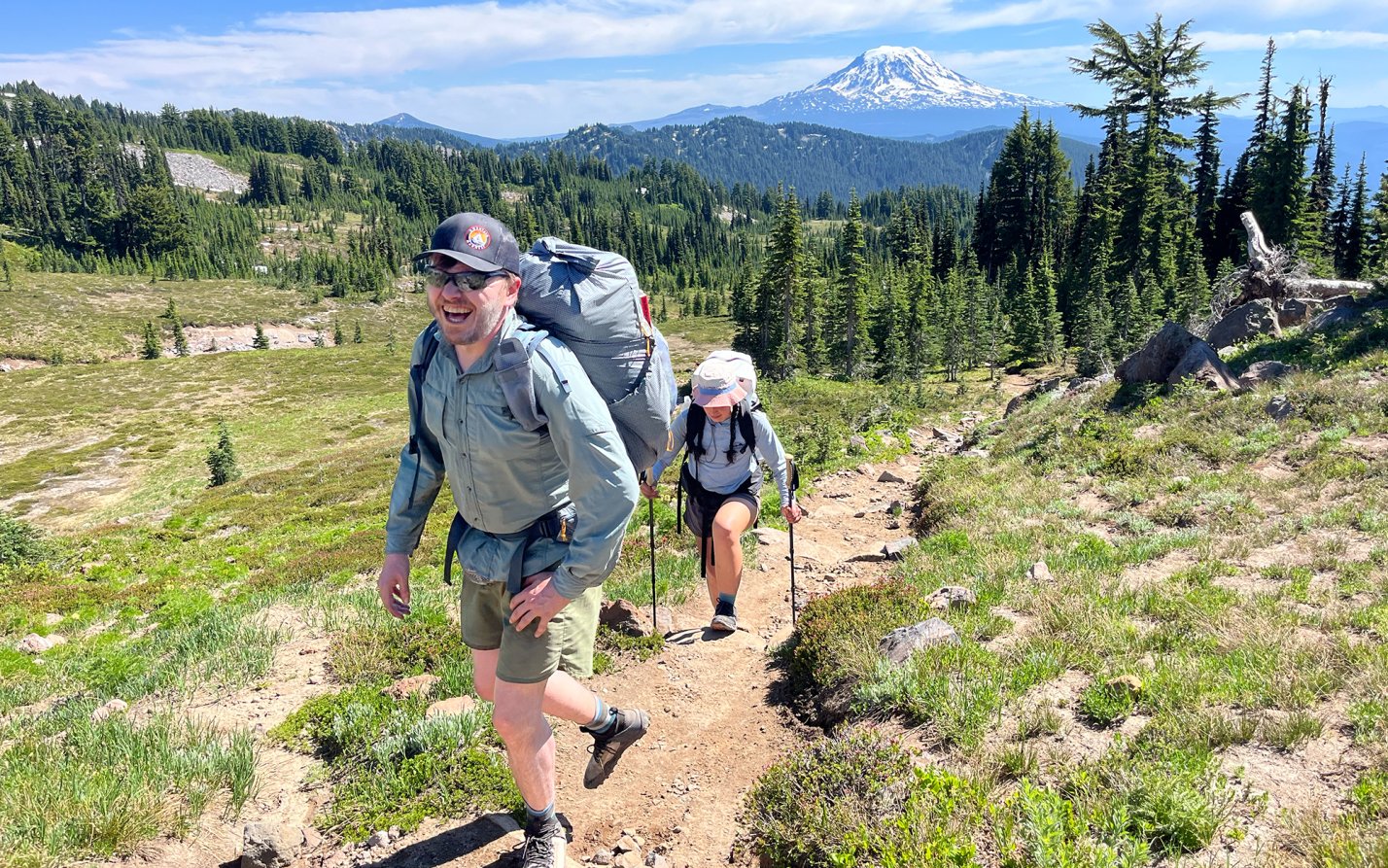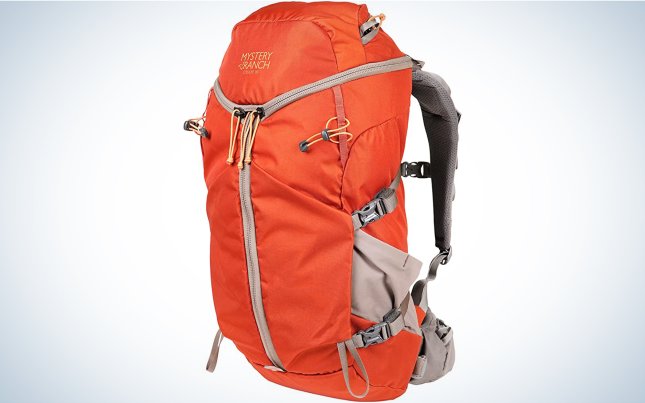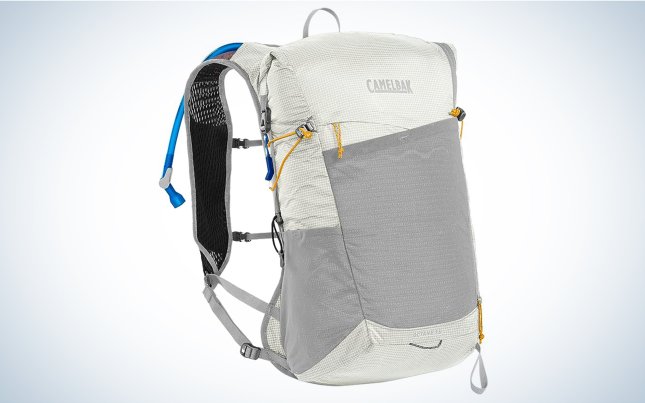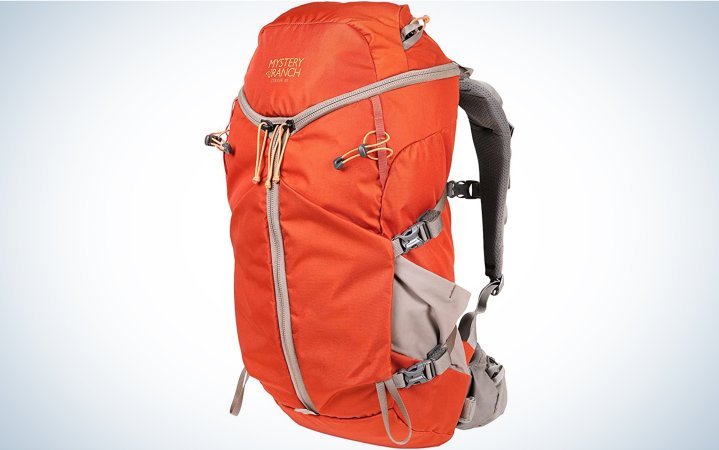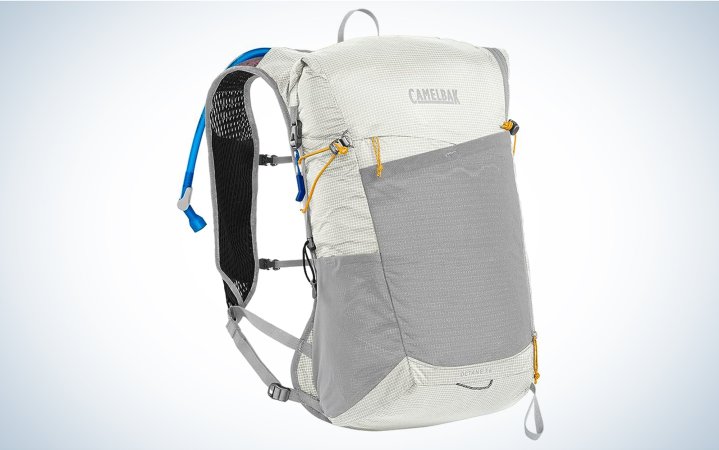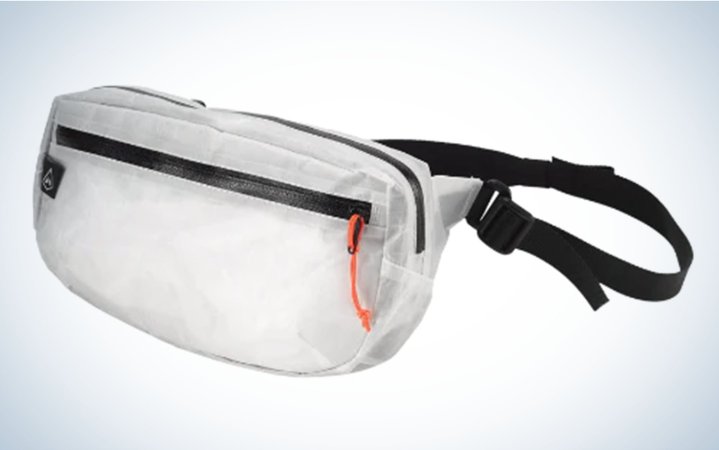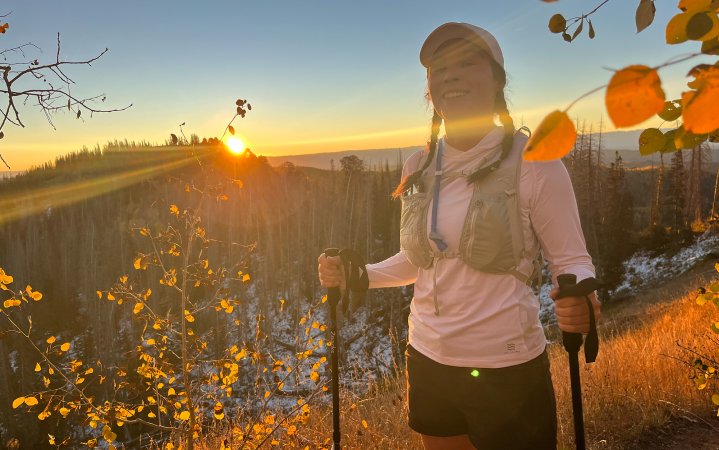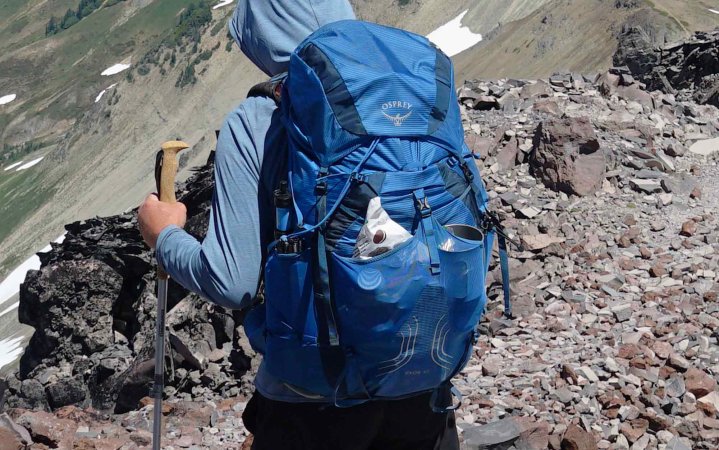We may earn revenue from the products available on this page and participate in affiliate programs. Learn More ›
Sure, you can go for a walk in the woods with nothing but the contents of your pockets, but if your pockets are bursting with granola bars with an extra layer wrapped around your waist while lugging around your water bottle, it might be time to invest in a hiking backpack. Outdoor Life editors and writers have tested a ton of backpacks over the years, and these are our top picks.
- Best Day Pack: Mystery Ranch Coulee
- Best Hydration Pack: CamelBak Octane 16 Hydration Hiking Pack
- Best for Winter: Mountain Hardwear Powabunga 32
- Best Fanny Pack: Hyperlite Versa
- Best Running Vest: CamelBak Zephyr
- Best for Backpacking: Osprey Exos 48
- Best Backpack Cooler: Hydroflask Day Escape
How We Tested the Best Hiking Backpacks
While day hiking, trail running, backpacking, and scrambling, OL writers and editors have put thousands of miles into testing the best hiking backpacks. When testing a pack, we focus on comfort, capacity, and ease-of-use. Other features like hydration capability, pockets, and waterproofness also factor into our reviews. We’ve selected the best hiking backpacks in a range of sizes suited for different hiking styles.
Best Hiking Backpacks: Reviews & Recommendations
Best Day Pack: Mystery Ranch Coulee
Pros
- Great padding
- Easy to access every item in your pack
- Fully adjustable
Cons
- Heavy
- Slight ridge in the back panel is somewhat distracting
Key Features
- Capacity: 30 liters
- Weight: 43 ounces
- Support: Full
- Not waterproof; no provided raincover
If you’re new to hiking, it would be hard to go wrong with the Mystery Ranch Coulee. It’s not only the most comfortable pack in my test, with great padding along the hips and shoulders, it’s also the most forgivable if you pack it wrong. While most daypacks have a single top-entry point to the main compartment, the Mystery Coulee can be fully unzipped down to the bottom of the pack, and then easily stuffed and zipped back up again.

There were no stiff or rigid features along the back panel or any of the straps (although a slight seam was noticeable), making it easy to conform the pack to my body. At the same time, the back panel had just enough structure to push some of the weight off my shoulders in the event I ended up carrying a heavier load. This was also one of only two daypacks I looked at (along with the Gregory Zulu) that had an adjustable back panel. (Mystery Ranch also provided an easy-to-follow video on how to go about adjusting the back panel for maximum comfort). —Laura Lancaster
Read Next: Best Hiking Daypacks
Best Hydration Pack: CamelBak Octane 16 Hydration Hiking Pack
Pros
- Roll-top closure for pack and zipper closure for reservoir
- Dual sternum straps and vest-style shoulder straps
- Multiple pockets
- Various points of reflectivity
- Red poppy color good for hunting season
Cons
- Heavy weight-to-capacity ratio
- Small volume for gear
Key Features
- Weight: 1 pound, 7 ounces
- Gear Capacity: 14 liters
- Reservoir Capacity: 2 liters
- Pockets: Main body stretch overflow pockets, two mesh side pockets that fit 32-ounce bottles, angled smaller pocket on one side, two pockets on oversized shoulder straps
- Unisex
The CamelBak Octane 16 is best suited for trail running and summer hiking when there’s not much of a consequence for carrying a lighter load. It delivers a lot of bells and whistles, especially for its price point.
There is a vest-like harness, oversized shoulder straps, and two sternum straps, but no hip belt, so our tester limited her load since the majority of the weight was on her shoulders. Still, she successfully carried up to 15 pounds by filling the 2-liter bladder with water. The rest of the internal compartment held a fleece and a rain shell, and she stashed snacks, a first aid kit, sunscreen, and a dog leash into the six remaining pockets. The roll-top closure allowed top access to the main compartment. A full-length vertical zipper allowed access to the bottom items.
Camelbak’s new Fusion reservoirs are designed for ease. They have a rigid backplate to help with drying, a grip for single-handed filling at sinks, and a durable and secure zipper closure that is not fussy at all. The reservoir has a dedicated spot in the pack with a buckle attachment. The hose goes through a hole, then a bungee over the shoulder, and stays in place with a clip. The bite valve is designed to deliver more water for each sip.
The ridged foam of the pack molded to the tester’s back with an overlay of mesh for airflow, but she noticed some sweat along the mesh front straps when temps rose to 90 degrees in Oregon. —Patrice La Vigne
Read Next: Best Hydration Packs
Best for Winter: Mountain Hardwear Powabunga 32
Pros
- Insulated hydration tube routing
- Removable sternum strap with whistle
- Top zip fleece-lined goggle pocket
Cons
- Ski loop cannot be stowed
Key Features
- Material: 500D Nylon
- Weight: 51.4 oz
- Sizes: S-M, M-L
- Dedicated Safety Tools Pocket: Yes
- Goggle Pocket: Yes
- Hipbelt Pockets: Single right-side zipper pocket
- Helmet Holder: Yes
- Hydration System Compatible: Yes
- Diagonal, A-frame, and centered carry options for skis and snowboard
- Back panel zipper for easy access
The Powabunga’s padded hipbelt system provides mobility while the suspension moves with your natural stride. The load lifter straps at the base of the neck, along with side compression straps and intuitive hipbelts, make this pack so streamlined to your body you’ll forget you have it on. The spring steel frame also provides flexibility, while retaining stable load transfer.
This pack is also well-equipped for skiing and boarding with a front helmet hammock that stows in a pocket and straps to carry your sticks or board. The front panel is foam-reinforced to protect against diagonal ski or board edges and tools. The back panel is moisture wicking and snow shedding.

While there is an additional access point to the main compartment besides the back panel, it is inside the google pocket which can be restricting. However, there are large vertical side zipper pockets with expandable bellows for skins, extra gloves, or water bottles that are easy to access and aid in organization. The hipbelts are also adjustable and there is one pocket for hand warmers or snacks.
Read Next: Best Winter Backpacks
Best Fanny Pack: Hyperlite Versa
Pros
- Ultralight
- Removable waist strap
- Open-top stash pocket
Cons
- Straps are a little annoying to adjust
Key Features
- Belt Size: 35 inches max (measured)
- Weight: 4.27 ounces
- Capacity: 2.5 liters

I wore this pack backpacking and it forever changed the way I hike. Over a 40-mile trip, I kept essentials like my phone, headphones, pocket knife, bug spray, hand sanitizer, snacks, sunglasses, toothbrush, and toothpaste in this for easy access at my waist in conjunction with my hipbelt. I was able to keep the bug spray in the front zipper pocket so that no leaking DEET could contaminate my toothbrush and snacks. The roomy stash pocket was perfect for pulling my phone out to capture critters on camera or quickly check my map. You can remove the belt if you want to attach it to your hipbelt instead, as the stash pocket features two holes to slide it onto any strap less than 3 inches thick.

If I wanted to explore after dropping my bag at camp, it was large enough to fit the best ultralight sandals and sunscreen or a liter bag of water. It’s only water resistant, not waterproof as there is a gap between the dual zippers, but the lightweight Dyneema hybrid material is waterproof and very durable. I think the white model with orange zippers looks smart, but it is already getting dirty, as expected. It’s hard to care when I can easily spot the bright white in my dim tent when looking for some essential item inside.
Read Next: Best Hiking Fanny Packs
Best Running Vest: CamelBak Zephyr
Pros
- Detachable trekking pole quiver
- Secure fit
- Whistle
Cons
- One size
Key Features
- Sizes: One size, men’s and women’s
- Weight: 7.4 ounces
- Capacity: 11 liters
- Includes two 17-ounce Quick Stow flasks
- Compatible with hydration bladder
I’ve been running in the Zephyr for a year now, and it’s my go-to vest. I love the ability to stow my trekking poles in the detachable quiver while running downhill. The vest itself is secure with plenty of water capacity.

There’s room in the back for an extra layer and I keep my car key, snacks, phone, and AirPods case in the plethora of front pockets. It’s easy to adjust the bottom and chest sliding straps for an optimal fit and no jostling. I’ve run in fall layers and thin summer tank tops and it fits securely over any outfit.
I’m partial to hydration bladders and keep the chest flask pockets open for storage. I love the CamelBak bladder and the hose clips onto the chest easily. While I don’t typically run in oppressive heat, the Zephyr is breathable and doesn’t smell despite never washing it.

The materials are very lightweight and I love the color way. The light green hasn’t gotten dirty and doesn’t absorb heat. There are also reflectors for visibility. I think this is the ultimate all-around women’s vest for day hikes, long runs, and even to bring backpacking for a lightweight day pack away from camp.
Read Next: Best Running Vests
Best for Backpacking: Osprey Exos 48 and Eja 48
Pros
- Best-in-class load bearing
- Unparalleled back panel ventilation
- Removable top lid pocket makes this a good option for those transitioning to a lightweight style
- Easy-to-use toggle system to adjust the height of the back panel
- Affordably priced
- Great warranty
Cons
- Too-tight pockets
- Fiddly compression straps
Tested in the Goat Rocks Wilderness by Adam Tycaster, Sven “Magic” Anderson, Alex Robinson, and Diana Helmuth
Report Card
- Fit: 4.25
- Comfort: 4
- Load Bearing: 4.25
- Packability: 4
- Accessibility: 3.5
- Value: 5
Key Features
- Price: $240
- Capacity: 48 liters
- Weight: 2 pounds, 12.7 ounces
- Men’s (Exos) Torso Fit: 17 to 23 inches
- Women’s (Eja) Torso Fit: 13 to 19.5 inches
- Pockets: Removable top lid pocket, two side stretch pockets, back mesh pocket, two hip belt zip pockets
- Adjustment Points: Attached hip belt, shoulder straps, load lifters, adjustable back panel, sternum strap
- Comfortable up to 35 pounds (as reported by the testers)
- Warranty: Lifetime guarantee
It is extremely tough to make a proper rigid-frame load-bearing backpack that comes in under three pounds, but that is exactly what the Osprey Exos is. There is no soft back panel that must be packed exactly so or soft foam that rests right up against your pack. It boasts proper aluminum stays with superb airflow across the back panel. “The Osprey was a very comfortable pack,” noted Magic. “I literally felt like I had an air conditioner on my pack.” Robinson carried this pack on the last (and longest) day, when the mosquitoes were at their worst, noting that “It rode on my back comfortably and I loved the venting.”

When you look at the side profile of the Osprey Exos, you can easily see the broad arc at the back panel, bracketed by the aluminum stays, that’s responsible for all that extra airflow while transferring the majority of the weight to your hips. It’s worth noting that shifting the center of the backpack’s load away from the back can, with too-heavy loads, start to pull back on the shoulders uncomfortably. However, our testers, who carried loads ranging from 25 to 31 pounds, reported no issues with the load pulling away. (Robinson did note that after carrying this backpack for over 10 miles, the bottom of the curve began to dig into his hip uncomfortably.) Testers similarly reported that the Z-shaped compression straps were a bit onerous to tighten and loosen throughout the day, but that they did their job of streamlining their load into a more aerodynamic profile.

What they did have issues with are the pockets. Multiple testers, including Magic, who has Parkinson’s, noted that the tight pockets on the Osprey Exos limited their ability to access gear. Helmuth also noted that the hip belt pockets rode unusually far back on her hips, limiting her ability to use them throughout the day.
One feature I appreciate about the Osprey Exos is that it has a mid-sized removable brain. For backpackers transitioning to a lightweight kit, this can help ease some of the organization retooling that comes with having fewer pockets and straps, while also ensuring they don’t unnecessarily load up the brain with heavy items (making it top heavy). Then, once they’ve got their kit truly dialed in, they can remove the brain, saving a cool 4 ounces in the process.

My one quibble here is that the alternative closure to this pack is a useless piece of fabric that only exists to cover the drawstring closure. Backpackers who choose to keep the top lid are then carrying around extra weight to no purpose (unless they are brave enough to cut it off permanently). And lightweight backpackers are also getting the short end of the stick as drawstring closures neither provide as much potential carrying capacity as roll-top closures, nor do they pack down smaller loads as cleanly. But these are all comparatively small complaints next to what the Osprey does best: lightweight best-in-class suspension and back ventilation. —Laura Lancaster
Find more of the best backpacking backpacks in alternate frame styles.
Best Backpack Cooler: Hydroflask Day Escape

Pros
- Very comfortable to carry
- Waterproof
- Mesh pocket
Cons
- Not the best ice retention
Key Features
- Capacity: 20 liters
- Weight: 2.6 pounds
- Insulation Test: 48 hours
The Hydroflask Day Escape has one of the most comfortable carries I’ve tested. This is what I would bring with me on a day hike, or really any carry longer than 50 yards. This is in large part due to its shape: It has a wider frame, with less depth, which holds the weight closer to your body than models that were free form or structured like a traditional cooler.
While the backpack had (just) enough structure to support a heavier load, the lack of hip belt means that you should resist the urge to fully load this one up before heading out on a longer hike. One feature common to backpacks but not to backpack coolers that the Day Escape included was a haul handle, which is handy for at-home storage.

In addition to being comfortable, the Hydroflask Day Escape also has all the hallmarks of one of the great backpack coolers, being fully waterproof and holding ice for 37 hours during my insulation test — not the longest in my test, but plenty for a picnic or day hike. I also liked that it had an outside mesh pocket — useful for stashing small items or needing somewhere to stick your trail beer on the go. —Laura Lancaster
Read Next: Best Backpack Coolers
Things to Consider Before Buying the Best Hiking Backpack
Capacity
Usually measured in liters, the capacity of your bag dictates how much stuff you can bring on your hike. The Hyperlite Versa fanny pack holds 2.5 liters while the Osprey Exos backpacking backpack holds 48 liters. A happy medium for a day hike is 10 to 30 liters depending on how you pack, what season it is, and how intense your hike is. During the winter, you’ll likely need more food and layers, so a more spacious bag makes sense. If all you need is less than 2 liters of water, a light layer, and a few bars, you could get away with a running vest, which fits more snugly for high-intensity adventures.
Comfort
Once you’ve decided on the right bag capacity for your hiking style, comfort is the most important factor when choosing the best hiking backpack. Most backpacks have adjustable shoulder straps, but if you’re looking for more support, hipbelts can transfer some of the load from your shoulders to your hips. Load lifters and sternum straps are other adjustment points that can increase the comfort of your backpack.
Ease of Use
Check out the number of pockets, how easy it is to access them, and where they’re located when picking out your new pack. More pockets can help you organize your stuff, but they do add weight.
FAQs
A backpacking backpack is designed to carry a heavier load and more supplies than a hiking backpack. Typically you’d use a backpacking backpack for overnight trips and hiking backpacks on shorter excursions.
A happy medium for day hikes would be a 10- to 30-liter bag. You can fit your water, compact lunch, snacks, headlamp, first-aid kit, and extra layers in a bag that size easily. If you’re buying a hiking backpack for an avid hiker, 18 to 25 liters is a great starting point.
Your backpack should fit snugly enough that it isn’t swaying around, disrupting your balance and stride, but not so tight that it’s restricting your range of motion or breathing in any way.
Final Thoughts on the Best Hiking Backpacks
Next time you’re overstuffing fruit snacks in your pocket or getting resentful of the Nalgene in your hand, grab one of the best hiking backpacks to bring everything you need on your next adventure. The Mystery Ranch Coulee is the perfect size for day hikes of any intensity. If you’re planning an overnight trip, the Osprey Exos is the most comfortable rigid frame backpacking pack.
- Best Day Pack: Mystery Ranch Coulee
- Best Hydration Pack: CamelBak Octane 16 Hydration Hiking Pack
- Best for Winter: Mountain Hardwear Powabunga 32
- Best Fanny Pack: Hyperlite Versa
- Best Running Vest: CamelBak Zephyr
- Best for Backpacking: Osprey Exos 48
- Best Backpack Cooler: Hydroflask Day Escape
